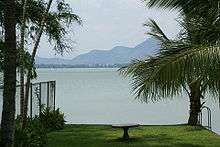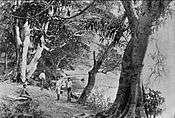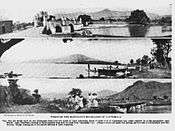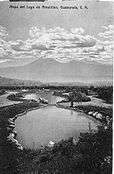Lake Amatitlán
| Lake Amatitlán | |
|---|---|
|
The lake under Pacaya volcano (in background right) | |
| Location | south-central Guatemala |
| Coordinates | 14°28′16″N 90°34′54″W / 14.47111°N 90.58167°WCoordinates: 14°28′16″N 90°34′54″W / 14.47111°N 90.58167°W |
| Primary inflows | Villalobos River |
| Primary outflows | Michatoya River |
| Catchment area | 368 km2 (100 sq mi)[1] |
| Basin countries | Guatemala |
| Max. length | 11 km (6.8 mi) |
| Max. width | 3 km (1.9 mi) |
| Surface area | 15.2 km2 (5.9 sq mi)[1] |
| Max. depth | 33 m (108.3 ft)[1] |
| Water volume | 0.286 km3 (0.1 cu mi)[1] |
| Surface elevation | 1,188 m (3,897.6 ft)[1] |
| Frozen | Never[1] |
| Settlements | Amatitlán, Villa Canales, Villa Nueva |
| References | [1] |

Lake Amatitlán (Lago Amatitlán, Spanish pronunciation: [laɣo amatiˈtlan]) is a volcanic lake in south-central Guatemala, fairly close to Guatemala City. It lies in the central highlands, 1,186 m (3890 feet) above sea level.[2] Its maximum depth is 33 m (108 feet) and an average of 18 m (59 feet). The lake is 11 km (7 miles) long and 3 km (2 miles) wide; with an area of 15.2 square kilometers (5.9 sq mi) and a water volume of 0.286 cubic kilometers.
The lake's primary inflow is the Villalobos River, and the lake is drained by the Michatoya River, an important tributary of the María Linda River. The town of Amatitlán is situated at the head of the Michatoya river. A dam with a railway on top was constructed at the narrowest point, thus effectively dividing the lake into two water bodies with different physical, chemical and biological characteristics: a north-western and a south-eastern basin.
The lake is used as a water source, for navigation and transportation, sightseeing and tourism (10,000 visitors annually), recreation (swimming, sport-fishing, water skiing, yachting) and fisheries.
History
As of 1850, the lake was used as a bathing lake and a resort area in the spring. Nearby hot springs were also popular with visitors.[3]
Economy
In the mid 19th century, the lake was plentiful with crawfish, sardines, and other seafood. The seafood was captured and sold for the local region, as seafood was rarely imported into the area.[3]
Pollution
Amatitlán lake's catchment area includes Guatemala City. Each year large quantities of untreated sewage, industrial waste and a staggering 500,000 tons of sediment are carried into the lake through the Villalobos River.[4] This has contributed to high levels of pollution of the lake's water, and an accelerated eutrophication and siltation.[1][5] This has seriously affected the lake's former function as a source of drinking water and irrigation, and reduced its recreational functions.
In early 2015, the Lake Amatitlan Authority commission granted a contract to the Israeli company M. Tarcic Engineering Ltd. for 137.8 million quetzals, to purchase 93 000 liters of an alleged decontaminant that it would apply to Lake Amatitlán. However, after complains and legal action from scientists, academia, politicians and environmentalists who questioned the Israeli company contract, then vicepresident Roxana Baldetti suspended the project on 30 March 2015 and froze both the payment to the company and any decontaminant pouring into the lake.[6] Furthermore, Baldetti was forced to resign in early May 2015 due to the La Linea corruption case and was sent to prison on 21 August 2015.
Gallery
![]() Media related to Lago de Amatitlán at Wikimedia Commons
Media related to Lago de Amatitlán at Wikimedia Commons
 1897[7]
1897[7] Early 20th century
Early 20th century Lake model in «La Aurora» zoo in Guatemala City, ca. 1925.
Lake model in «La Aurora» zoo in Guatemala City, ca. 1925.
Notes and references
References
- 1 2 3 4 5 6 7 8 "Data Summary: Lago de Amatitilan". International Lake Environment Committee Foundation - ILEC. Retrieved 2009-01-03.
- ↑ INSIVUMEH. "Indice de lagos". Retrieved 2008. Check date values in:
|access-date=(help) - 1 2 Baily, John (1850). Central America; Describing Each of the States of Guatemala, Honduras, Salvador, Nicaragua, and Costa Rica. London: Trelawney Saunders. p. 60.
- ↑ Reyna, Evelyn Irene. "Integrated Management of the Lake Amatitlan Basin: Authority for the Sustainable Management of Lake Amatitlan and its Basin". Retrieved 2009-03-05.
- ↑ Global Nature Fund. "Lake Amatitlan - Guatemala". Retrieved 2008. Check date values in:
|access-date=(help) - ↑ Rodríguez, Manuel (30 March 2015). "Baldetti suspende plan para "limpiar" lago de Amatitlán". Diario La Hora (in Spanish). Guatemala. Archived from the original on April 23, 2015. Retrieved 23 April 2015.
- ↑ Valdeavellano 1897, p. 200.
Bibliography
- Anton, Danilo J. (1993). Thirsty Cities: Urban Environments and Water Supply in Latin America. Ottawa, Ont.: International Development Research Centre (IDRC). ISBN 0-88936-666-7.
- Muñoz, c.; Velasquez, E.; Aragon, Y.R. (1978). Estudio de aguas subterráneas en el Valle de la Ciudad de Guatemala (in Spanish). Guatemala City: Ministerio de Comunicaciones y Obras Publicas, Instituto Nacional de Sismología, Vulcanología, Meteorología e Hidrológica.
- Valdeavellano, Alberto G. (1897). "Orillas del Lago de Amatitlán". La Ilustración Guatemalteca (in Spanish). Guatemala. I (14). Retrieved 27 April 2015.
External links
- Instituto Nacional de Sismología, Vulcanología, Meteorología e Hidrolagía (INSIVUMEH)
- Global Nature Fund - Lake Amatitlan - Guatemala